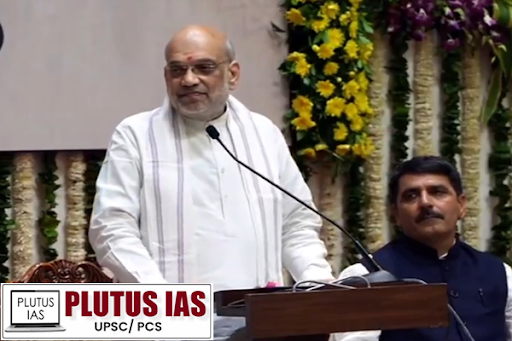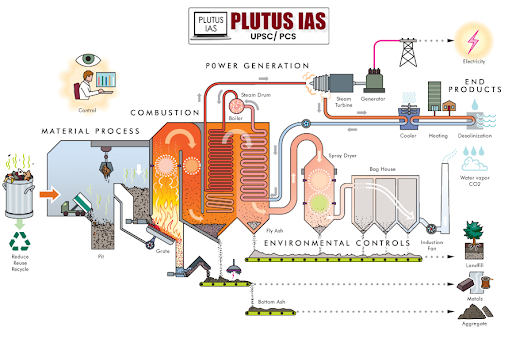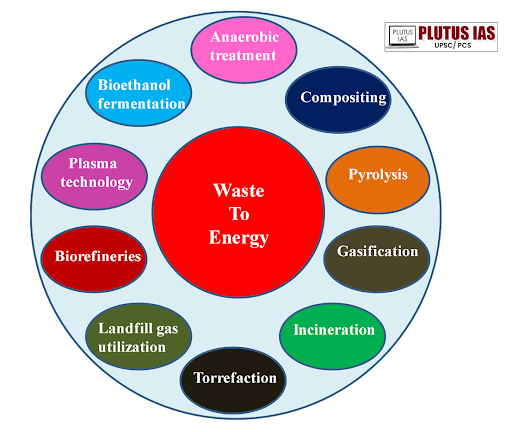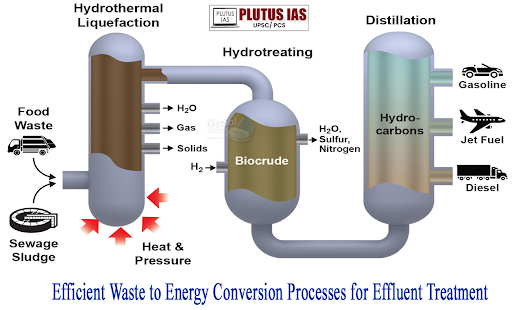02 Nov “Transforming Waste into Power: India’s Approach to Waste-to-Energy Solutions”
This article covers “Daily Current Affairs” and topic details “Waste-to-energy (WTE) methods”
Syllabus mapping:
GS-3: Environment: Pollution and methods to combat the pollution
For Prelims:
What are gasification, membrane filtration, pyrolysis, and incineration, their advantages and disadvantages?
For Mains:
What is the Significance of the waste energy methods and the challenges associated with these methods? What are the ways to make these methods sustainable to achieve the NDC targets?
Why in the news?
HM Amit Shah inaugurates Gujarat’s largest waste-to-energy plant in Ahmedabad. The largest waste-to-energy plant in Gujarat, located at Pirana Piplaj Road in Ahmedabad, is a collaboration between the Government of Gujarat and the Jindal Urban Waste Management Company. The plant can generate 15 megawatts of energy from 1,000 metric tonnes of solid waste daily. This initiative aims to create a greener future for Ahmedabad and serves as a model for effective waste management.

Waste-to-energy (WTE) methods
Waste-to-energy (WTE) methods refer to technologies and processes that convert various forms of waste into usable energy, typically electricity or heat. These methods utilize waste materials — such as municipal solid waste, agricultural residue, industrial by-products, and even wastewater — as feedstock, reducing the volume of waste that goes to landfills and creating renewable energy as an output.

Waste-to-energy (WTE) methods:
Incineration: Waste is burned at high temperatures, producing heat that generates steam and drives turbines to create electricity. This method reduces waste volume by up to 90% and is widely used, though it requires emissions control to limit pollution.
Gasification: Organic or carbon-based waste is heated in a low-oxygen environment, creating a synthetic gas (syngas) that can generate electricity, heat, or fuel. It produces fewer pollutants than incineration and allows for a cleaner energy conversion.
Pyrolysis: Waste materials, especially plastics, are thermally decomposed in the absence of oxygen, producing bio-oil, syngas, and char. Pyrolysis is often used for specific waste types, like tires or plastics, and can convert waste into fuels or chemicals.
Anaerobic Digestion (AD): Microorganisms break down organic waste in an oxygen-free environment, producing biogas (mainly methane and carbon dioxide) and digestate. The biogas can be used to generate heat, electricity, or as a natural gas substitute, while the digestate is often used as fertilizer.
Landfill Gas Recovery: Methane and other gases generated by decomposing organic waste in landfills are captured through wells and used to produce electricity, and heat, or upgraded to renewable natural gas. This process reduces greenhouse gas emissions from landfills.
Plasma Arc Gasification: High-temperature plasma torches break down waste materials into syngas and molten slag in an oxygen-starved environment. Plasma gasification is efficient and can handle a variety of waste, though it is costly and less widely adopted.
Biomass-to-Energy (BTE): Biomass waste, such as wood chips, agricultural residue, or organic industrial waste, is combusted or converted into biofuels. The resulting energy can generate electricity, provide heat, or be converted to biofuels like biodiesel or ethanol.
Membrane Filtration: This method involves using semi-permeable membranes to separate and filter contaminants from wastewater or other waste streams. In waste-to-energy applications, membrane filters can purify biogas or liquid waste, removing impurities and increasing the efficiency of anaerobic digestion or other bioconversion processes. This technology also enhances water reclamation and nutrient recovery, supporting sustainable waste management and energy production.

Advantages of Waste-to-Energy Methods:
Environmental Viability and Sustainability: Waste-to-energy (WTE) plants offer sustainable waste management solutions, reducing the volume of waste sent to landfills and lowering greenhouse gas emissions.
Reduction in Air Pollution: By diverting waste from incineration, WTE plants help decrease air pollution, as waste is processed in a more controlled environment.
Enhancement of Soil Fertility: Organic waste can be processed into bio-compost, which enriches soil fertility, supporting agricultural sustainability.
Sustainable Energy for Rural Areas: WTE facilities provide renewable energy to rural areas, promoting sustainable energy access across regions.
Supporting Nationally Determined Contributions (NDCs): WTE contributes to India’s goals under its NDCs by promoting renewable energy and lowering overall carbon emissions.
Improving Safety and Health for Children: Reduced pollution levels around waste sites contribute to a safer environment, particularly benefiting children’s health.
Boosting Renewable Energy Targets: Increasing renewable energy from WTE contributes toward India’s 40% renewable energy target, enhancing the country’s clean energy mix.
Membrane Filtration: Membrane filters are used in WTE processes to purify wastewater and remove impurities from biogas, improving efficiency in biogas production and enabling safe water reclamation for various uses.

Challenges to Waste-to-Energy Production in India:
Resource Limitations in Urban Bodies: Many local urban bodies lack the resources needed to implement waste-to-energy projects effectively.
Issues with Collection and Segregation: Inconsistent garbage collection and inadequate segregation of waste hinder effective waste management.
High Use of Non-Biodegradable Plastics: The widespread use of non-biodegradable plastics complicates waste-to-energy processes.
Limited Use in Urban Centres: Only a few urban centres effectively utilize waste-to-energy techniques for waste management.
Manpower Shortage: There is a shortage of skilled manpower dedicated to waste-to-energy projects.
Reliance on Conventional Dumping: Many major cities still rely on traditional waste dumping, as seen in Delhi, Chennai, and Mumbai.
Neglect of Tier 2 and Tier 3 Cities: Smaller cities often receive less attention for waste-to-energy initiatives.
Low Public Participation: There is limited public participation in adopting eco-friendly waste management practices.
High Initial Costs: The high initial cost of setting up waste-to-energy plants poses a financial barrier.
Lack of Access in Rural Areas: Many rural and panchayat areas are yet to benefit from waste-to-energy technology.
Way Forward:
Support via Smart City and National Rural Missions: Increased support through these missions can enhance waste-to-energy adoption in urban and rural areas.
Development of New Biopolicies: Biopolicies should focus on increasing the production and use of biodegradable waste.
Expand Swachh Bharat Mission to Remote Areas: Extending Swachh Bharat Mission efforts to remote areas can improve waste management.
Promote Public-Private Partnerships: Successful partnerships, like the Ahmedabad model, can reduce initial setup costs for waste-to-energy plants.
Raise Public Awareness: Campaigns by entities like the Kakinada Municipal Corporation can boost public engagement in waste management.
Amend Plastic Regulation Rules: Strengthening plastic regulations, as suggested by a parliamentary panel, could enforce stricter plastic usage controls.
Encourage Eco-Friendly Bags: Promoting alternatives like jute bags can help reduce plastic waste.
Mission LiFE for Household Waste Reduction: The Mission LiFE initiative can reduce household waste and promote sustainable living practices.
Adopt Advanced Technologies: Using algae and other innovative technologies can aid in degrading plastics and reducing waste.
Utilize Biopolymers: Incorporating biopolymers can significantly help in minimizing non-biodegradable plastic waste.
Ensure Medical Waste Segregation: Proper disposal and segregation of medical waste are essential for maintaining hygiene and safety.
Conclusion:
Waste-to-energy methods provide a transformative solution for energy generation by converting waste into usable energy, thereby reducing landfill use and greenhouse gas emissions. To fully harness this potential, it is crucial to invest in partnerships with private players and raise public awareness of the benefits. These combined efforts can lead to a new era of sustainable energy solutions.
Download plutus ias current affairs (ENG) 2nd Nov 2024
Prelims question:
Q. Which of the following are typically a product of waste-to-energy processes?
1. Electricity
2. Heat
3. Digestate (fertilizer)
4. Plastic
Select the correct answer using the code given below:
A. Only one
B. Only two
C. Only three
D. All four
ANSWER: C
Mains questions:
Q. What are the key benefits and challenges of implementing waste-to-energy methods in India, and how can these challenges be effectively addressed?
( Answer in 250 words)




No Comments